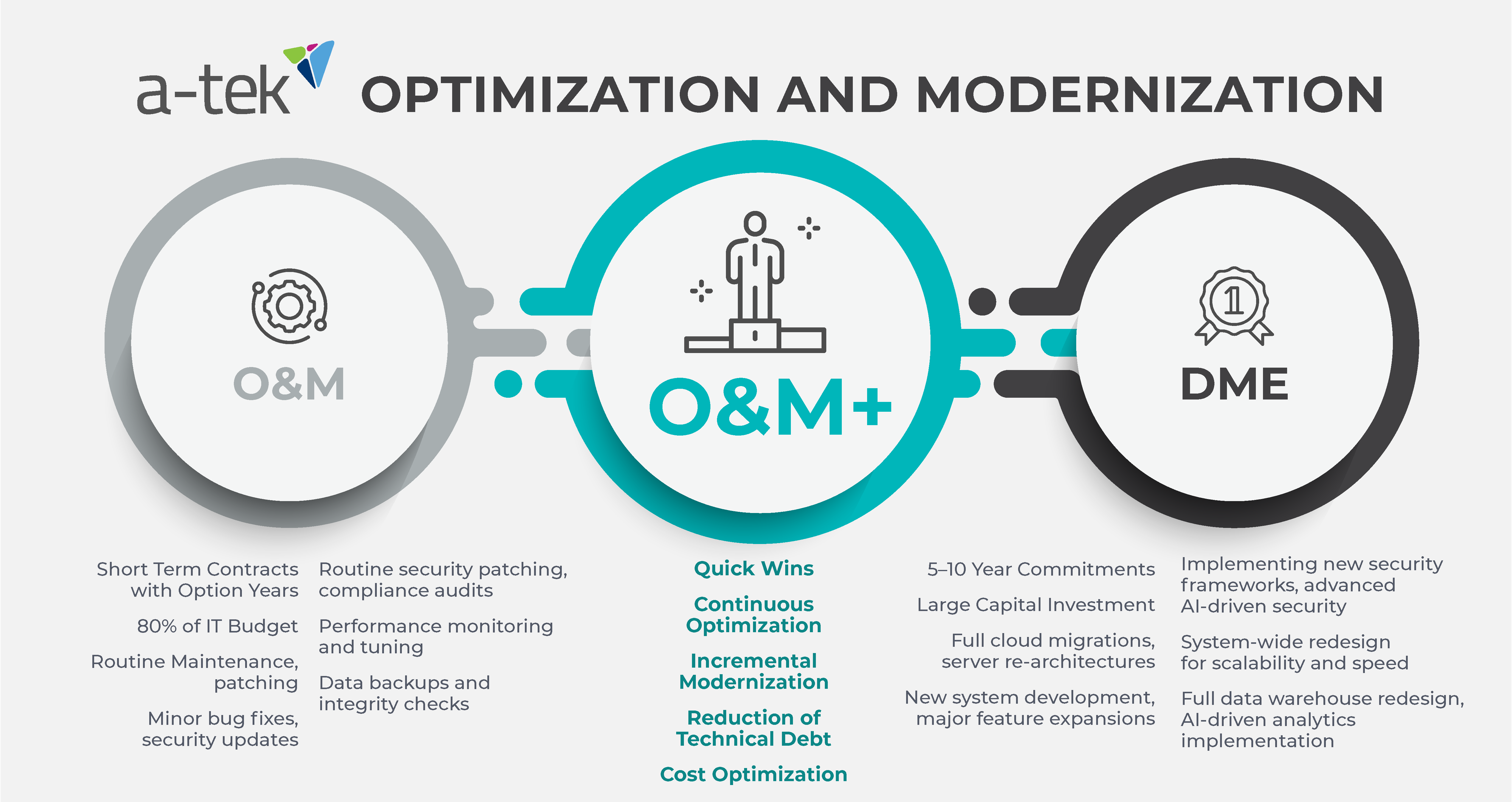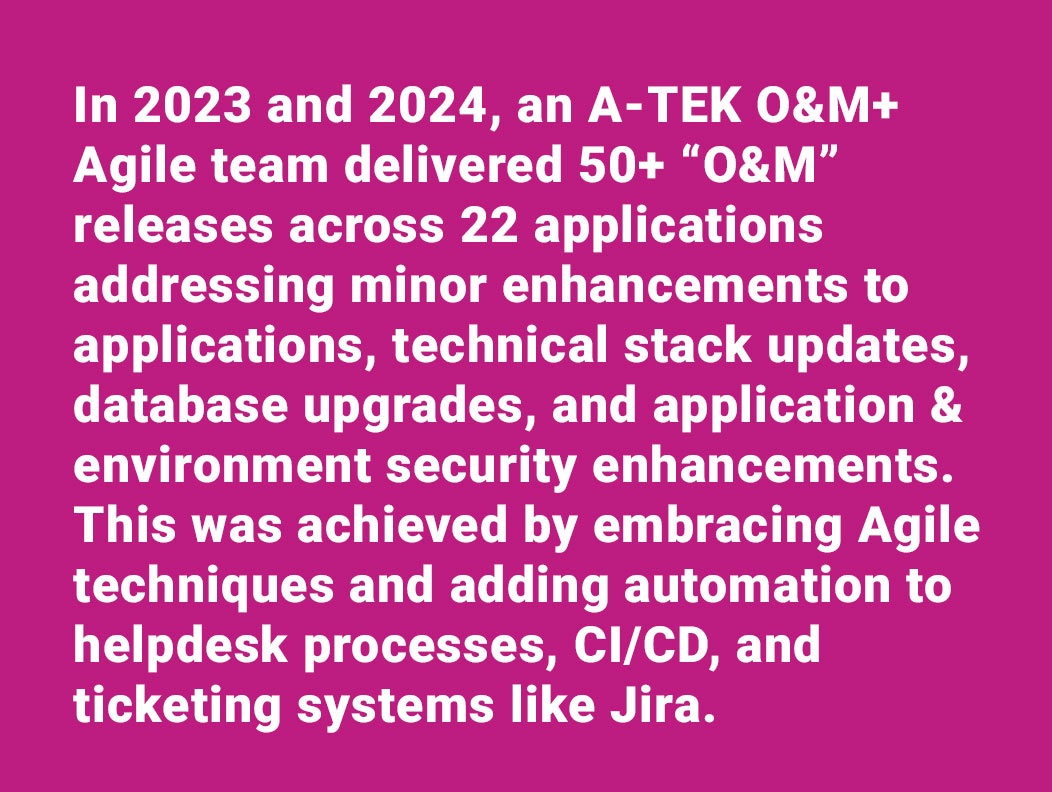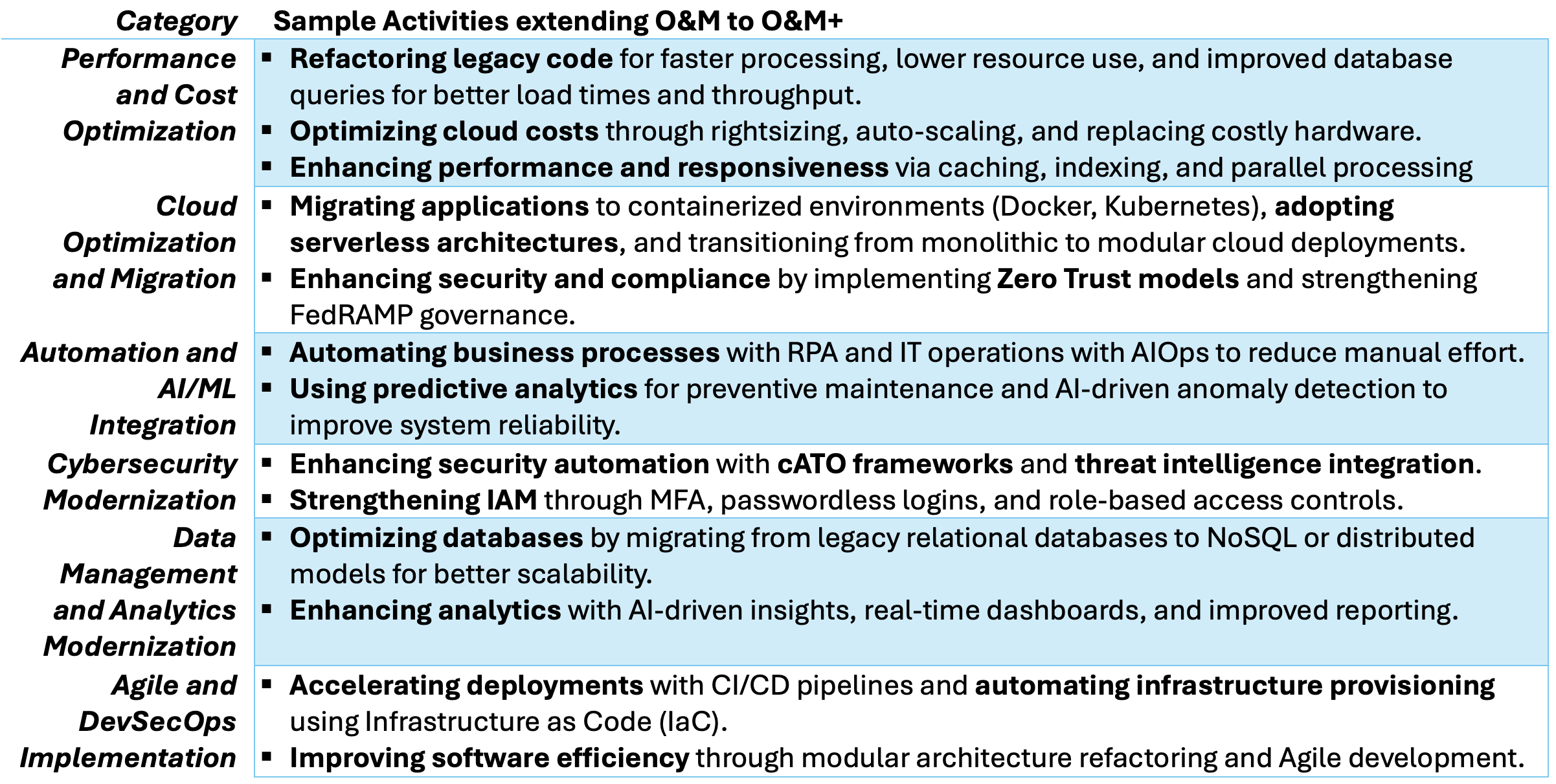Federal agencies spend over 80% of their IT budgets on Operations & Maintenance (O&M)—sustaining legacy systems that, while necessary, often lead to stagnation, inefficiency, and escalating costs. Meanwhile, Development, Modernization, and Enhancement (DME) initiatives offer transformation but require significant capital investments, long lead times, and complex procurement pathways. The challenge? Most agencies are stuck between maintaining outdated systems and funding full-scale modernization. In today’s environment, the reality is our Federal partners are adjusting to changes and challenges from staff reduction and budget cuts, and expectations to deliver services with fewer resources, all while staying within the bounds of the color of money. Traditional models of O&M and DME will be forced to evolve.

A-TEK’s Optimization and Modernization (O&M+) provides a practical, cost-effective, and iterative approach to IT modernization—maximizing sustainment budgets while integrating cloud efficiencies, automation, AI-driven optimizations, and security enhancements. Rather than waiting for large-scale DME funding, agencies can modernize incrementally within existing O&M contracts, reducing costs, improving performance, and strengthening cybersecurity without disrupting operations. Our approach transforms traditional O&M into a strategic enabler of efficiency, resilience, and security. Learn how our O&M+ approach helps Federal agencies:
- Optimize Infrastructure & Reduce Costs – Leverage automation, cloud scalability, and AI-driven analytics to reduce IT spending by 5% or more.
- Modernize Without Full Rebuilds – Enhance performance, implement Zero Trust security, and refactor applications without waiting for DME funding.
- Extend System Life While Preparing for Future Upgrades – Align incremental modernization efforts with long-term IT strategy.
- Drive Agile, Continuous Improvement – Deliver results through CI/CD, DevSecOps, and iterative development, enabling faster, lower-risk upgrades.
Traditional Sustainment
Traditionally, Federal Operations and Maintenance (O&M) contracts are structured as one-year contracts with 3-5 option years and only cover the activities necessary to sustain an existing IT system, ensuring it continues to operate efficiently, securely, and in compliance with regulations. These contracts are typically reactive and focus on break/fix, routine support, minor modifications, and preventive maintenance rather than significant new capabilities. Activities such as routine security patching, compliance audits, standard performance monitoring and tuning and minor bug fixes simply maintain the status quo and represent no significant improvement in the overall performance, optimization, reliability, sustainability, security, or cost effectiveness of the application or infrastructure. O&M contracts are restricted on scope for innovation, as they primarily focus on sustaining existing systems rather than modernization. Budget constraints and legacy system dependencies drive up long-term costs, while vendor lock-in and regulatory requirements add complexity. Performance and security risks arise when contracts emphasize reactive maintenance over proactive improvements. Transition challenges, workforce limitations, and rigid procurement rules can hinder flexibility, making it difficult to adapt to evolving IT and cybersecurity needs. Ultimately, these contracts often prioritize short-term stability over long-term IT strategy, requiring careful planning to mitigate risks.
 Modern Enhancement and Transformation
Modern Enhancement and Transformation
On the contrary, Federal Development, Modernization, and Enhancement (DME) contracts focus on activities that develop new capabilities, radically modernize or replace existing systems, or significantly enhance IT systems. These projects typically involve new software development, infrastructure overhauls, and major system upgrades. Requiring large capital expenditures and 5–10-year contracts, DME efforts result in advances in technologies, novel framework development and implementation, enterprise level architecture changes, and upgrading, expanding, or replacing existing IT systems to meet evolving mission needs and technological advancements. These contracts emphasize innovation and transformation rather than routine upkeep. DME contracts are designed to drive digital transformation, improve cybersecurity, and enhance operational efficiency, ensuring federal IT systems remain modern, secure, and scalable.
Optimizing and Modernizing in The Gray Area
Then there is the grey area, the area where the color of money can impact what you can and can’t complete on a given contract. O&M contracts are typically funded through sustainment budgets, we will call that green money, and DME contracts typically require multi-year funding and capital investments, we will call that orange money. While the distinction between O&M and DME is clear in most cases, and funding allocated for O&M cannot be used for items denoted as DME, there are gray areas where the two may overlap and areas where A-TEK can help agencies can supercharge their O&M, converting it to Optimization and Modernization (O&M+).

A-TEK’s O&M+ offering allows Federal Agencies to take advantage of sustainment funded contracts (orange money), with base and option year structures, to optimize systems, infrastructures, performance, and security, by incrementally modernizing code, infrastructure, architectures, security compliance. O&M+ is layered on top of traditional O&M to bring proactivity and forward-looking strategies critical to extending the life of legacy systems at reduced costs. Using Agile methodologies, DevSecOps and CI/CD along with modernization roadmaps, our teams identify areas of improvement either through removing technical debt, reducing cost, improving performance and reliability, or optimizing compute capabilities. As these areas of improvement align with standard O&M tasks, and as agile sprint velocity allows, our teams incorporate tasks to continually improve the cost, performance, and security of applications and infrastructure.
O&M+ represents a middle ground between traditional O&M and DME. It focuses on improving the efficiency, performance, security, and cost-effectiveness of existing IT systems without fully re-architecting or replacing them. O&M+ bridges the gap between maintenance and major upgrades, involving more than routine O&M but less than full-scale DME. It focuses on improving performance, reducing cost, security improvements, but instead of replacing systems, it enhances them through automation, cloud efficiencies, and performance tuning. O&M+ incorporates incremental modernization using an iterative approach to improve system capabilities without a complete redevelopment. The process extends system life while preparing for future enhancements, helping agencies maximize existing investments while ensuring a smoother transition to eventual DME efforts.

Conclusion
By layering O&M+ onto existing sustainment contracts, agencies can proactively modernize IT infrastructure, enhance security, and reduce technical debt—without the high cost of full system replacements. It provides a cost-effective, incremental approach to modernizing federal IT systems without full-scale redevelopment. Aligning with Federal objectives to increase efficiencies and do more with less, A-TEK delivers an O&M reduction plan which is on par with a risk management plan, project management plan, or quality assurance plan, describing how A-TEK will reduce costs by 5% or more through improved processes. O&M+ focuses on performance tuning, automation, cloud efficiencies, and security improvements, helping agencies reduce costs, enhance security, and improve efficiency while ensuring smoother transitions for future DME initiatives.
The future of Federal IT isn’t just about sustaining or transforming—it’s about strategic optimization. Schedule a call with our team to take a deeper dive into how O&M+ is bridging the gap between maintenance and modernization.

















